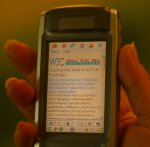The World Wide Web Consortium (W3C) has earned international recognition for its contributions to the growth of the Web: HTML, XML, CSS, etc. Recently published Web standards are Mobile SVG, SSML 1.0 and VoiceXML 2.0.
W3C's goal is to provide a Web for Anyone, Anywhere, Anytime, using Any Device. As part of it, the mobile Web technologies are currently one of the most active areas within W3C.
The mobile Web will make Web access from a mobile device as simple, easy and convenient as Web access from a desktop device. Even though many of todays mobile phones include Web browsers, accessing the Web from a mobile device has not become as popular as expected. Users and content providers are facing difficulties such as Web site usability and single authoring for all mobile phones offering Web access.
 W3C
in Hall 1 - A24
W3C
in Hall 1 - A24Over 28,000 visitors will have the opportunity to learn about W3C's efforts in mobile Web at the 3GSM 2005 Congress, from 14 to 17 February 2005, in Cannes, France. W3C's stand will be located in the main hall of the Palais des Festivals: Hall 1 - A24.
Read the press release.
Mobile Web technologies are currently one of the most active areas within the W3C, and for good reasons. The mobile Web enables new business opportunities for the mobile industry players. W3C works with other organizations to develop interoperable Web standards. OMA and 3GPP are using W3C standards for MMS, Web browsing and Multimodal Interaction.
Today’s Multimedia Messaging (MMS) systems use W3C’s SMIL technology for exciting multimedia content. Future MMS services will use W3C’s SVG for providing attractive vector graphics and animations (Mobile SVG, SMIL Mobile).
W3C standards lower the cost of producing content for mobile devices by emphasizing principles such as device-independent design. W3C standards allow authors to create content that can be adapted to match the strengths of specific mobile devices and user preferences (such as Composite Capability/Preference Profiles (CC/PP), Dynamic Properties Framework (DPF) and DI Select).
Browsing on a mobile phone should be as easy as on a desktop. W3C is working on specifications that will provide the end user with a smooth and enjoyable browsing experience (Compound Document Formats, XHTML Basic).
W3C develops standards that support multiple modes of interaction: aural, visual and tactile. Speech offers a welcome means to interact with mobile devices, allowing one-handed and hands-free operation (Speech Recognition Grammar Specification (SRGS 1.0), Speech Synthesis Markup Language (SSML 1.0), EMMA, VoiceXML 2.0 and InkML).
Following the tremendous success of the Mobile Web Initiative workshop held two months ago, and with the support of key players in mobile services, W3C expects to launch a Mobile Web Initiative in 2005. Dedicated to making access to the Web from a mobile device as convenient as from a desktop device, the Mobile Web Initiative will mostly focus on:
Marie-Claire is W3C's European Communications and Member Relations Officer.
Philipp Hoschka is W3C's Deputy Director for Europe. He is responsible for technical contacts with European research and development (including W3C Members and standards bodies). In addition to this work, Philipp heads the W3C Interaction Domain, which delivers key W3C specifications for Web multimedia and for enabling Web access with non-traditional devices such as mobile telephones.
Max Froumentin is the contact for two W3C Working Groups: the Voice Browser WG, which designs the VoiceXML family of standards for vocal interaction, synthesis and recognition and the Multimodal Interaction WG, which deals with universal access to the Web through any modality: screen, voice, keypad, stylus, etc.
Stéphane Boyera leads the W3C Device Independence Activity which deals with all mobile related technologies for both authors and users (eg. CC/PP). Stéphane is specialized in mobile content authoring, delivery context technologies and mobile Web.
Bert Bos is the contact for the W3C CSS Working Group. Bert's particular interest is the (re-)usability of information: letting both the author and the reader interact with the Web in novel and personal ways.
The W3C was created to lead the Web to its full potential by developing common protocols that promote its evolution and ensure its interoperability. It is an international industry consortium jointly run by the MIT Computer Science and Artificial Intelligence Laboratory (CSAIL) in the USA, the European Research Consortium for Informatics and Mathematics (ERCIM) headquartered in France and Keio University in Japan. Services provided by the Consortium include: a repository of information about the World Wide Web for developers and users, and various prototype and sample applications to demonstrate use of new technology. More than 350 organizations are Members of W3C. To learn more, see http://www.w3.org/
Press Resources